
Source: Gary Munkvold, Iowa State University
Symptoms:
Symptoms are not usually evident until harvest. Affected ears are lightweight with the cob shredding easily, usually at the base of the ear. Kernels are loose on the cob, slightly bleached with numerous round, black specks (spores) forming at the tip end of ear.
Dark gray or black mold is characteristic of this disease. It is usually more severe at the base of the ear, and the fungus also rots the cobs, causing them to fall off prematurely. Nigrospora ear rot is not associated with mycotoxins.
Cause:
Fungal disease caused by Nigrospora oryzae. The ear rot is promoted by conditions which adversely affect crop development, including drought, poor soil, frost, insects, or other diseases.
Management:
Plant a hybrid with ear rot resistance; avoid planting corn on corn, especially under conservation tillage, and reduce stress on the plants with adequate fertilization and good insect pest management.
References:
Lipps, P. E., A. E. Dorrance, and Dennis Mills. 2004. Corn Disease Management in Ohio Bulletin 802.
White, Donald G. (ed.). 1999. Compendium of Corn Diseases (3rd Edition). APS Press, The American Phytopathological Society.
